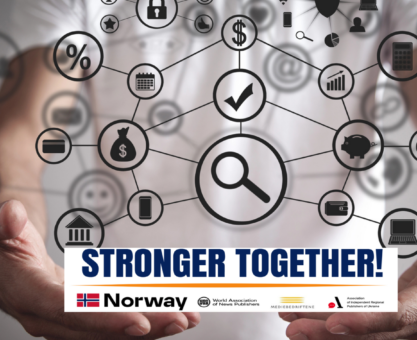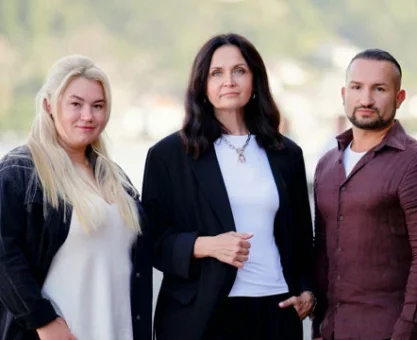Today, the front line in Ukraine often runs through cities and villages where civilians live. Daily life is marked by air raid alerts, shelling, and constant threats. In nearly every such region, a voice of truth still resonates — small, local, and independent media outlets. They do more than just report: they inspire hope, help communities stay resilient, debunk disinformation and enemy propaganda, and deliver fact-checked news that can save lives. They remain close to their audiences — despite evacuations, loss of offices, or destroyed equipment.
For these small but vital independent media that continue to serve their communities in wartime, the Association «Independent Regional Press Publishers of Ukraine», in partnership with the World Association of News Publishers (WAN-IFRA) and the Norwegian Media Businesses’ Association (MBL), and with the support of Norway, launched an institutional support program under the initiative «Stronger Together: Media and Democracy program».
The program aims to help Ukrainian regional media outlets become more financially resilient, better understand their audiences, and develop sustainable operating models during the war and the post-war recovery period.
Beacons of trust and voices of their communities
«Today, independent regional media in Ukraine are not just sources of news — they are often the only voice of the media ytruth that can still be heard in small towns under the most difficult conditions. We believe that by strengthening the resilience of local and regional newsrooms, we are reinforcing democracy and freedom of speech — not only in Ukraine but globally», — says Oksana Brovko, CEO of the Association «Independent Regional Press Publishers of Ukraine».
Among the 22 selected participants of the program are independent media outlets from across Ukraine. Each has a unique story, a distinct voice, and a deep connection with its local community. Despite the challenges of full-scale war, these newsrooms have not only maintained operations — they have become pillars of trust, information beacons, and symbols of civic resilience.
In this feature, we highlight three editorial teams that prove journalism can remain strong, adaptable, and deeply necessary — even in wartime:
«Berdyansk 24» — a media outlet from the temporarily occupied Zaporizhzhia region that continues to communicate with its hometown against all odds.
«Mayak-Media» from Bohodukhiv, Kharkiv region — a team that keeps reporting near the frontlines.
«Mahala» from Bolhrad, Odesa region — a newsroom preserving the region’s cultural diversity in times of heightened threats.
Each of them is a powerful example of perseverance. How do they keep going? We tell their stories.
Advertising disappeared — and the newspaper was printed on a home printer
The full-scale invasion caught Mayak (Bohodukhiv, Kharkiv region) in a state of shock and uncertainty. The outlet lost its funding, all advertising vanished, and circulation plummeted. The team operated in near-manual mode, documenting key developments for the local community — from evacuations and shelling to the efforts of volunteers and the territorial defense.
«Before the war, three of our 12 newspaper pages were filled with ads and announcements. After the full-scale invasion, there was none at all. In those early months, our print run dropped from 3,000 copies to just 300–400. Being in a frontline area, we had no access to Ukrposhta postal services, and our printing house in Kharkiv shut down. Public transport stopped running. We had no choice but to produce the paper in A4 format and print it ourselves», — says editor-in-chief Tetiana Luchynska.
As soon as the situation slightly stabilized, the printing house resumed operations and transportation to Kharkiv became available again. The team made an attempt to revive the full-format newspaper. Still, logistics were chaotic.
«When the shelling eased a little in early May, we — local editors — raised the alarm. Kharkiv’s Ukrposhta regional office eventually resumed its services. Our first properly distributed issue came out in May 2022», — Tetiana recalls.

Every edition of this frontline newspaper carries someone’s personal story. Tetiana remembers those chaotic days vividly.
«We relaunched a condensed four-page version, printed it in Vinnytsia — over 700 kilometers away. Delivery via Nova Post took five days. The sorting center in Kharkiv wasn’t working. Mail carriers were forbidden from delivering to rural subscribers. So we sorted copies ourselves, contacted each local branch to check how many issues had been prepaid. We used buses, acquaintances, and personal appeals to postal workers to help with informal delivery. Despite the inefficiencies and high costs, the newspaper reached our readers. You could find it in local shops, libraries, village councils — people read it and passed it from hand to hand».
The team’s priority was to preserve readers’ trust. During those months, the newsroom also transformed into a support hub for displaced people.
«Since March 2022, we’ve been holding weekly Mayak raffles and auctions to support Ukraine’s Armed Forces».

Going digital and exploring new formats
Despite the challenges, the small Mayak’s team — now made up of three staff members — has been actively developing new ways of delivering content online. Their main areas of focus include:
– expanding video production for social media
– producing short interviews, reports, and feature stories
– strengthening digital platforms (website, Telegram, Facebook)
– engaging younger audiences and reshaping how news is presented.
The newsroom has already started implementing its institutional support project under the «Stronger Together» program. According to editor-in-chief Tetiana Luchynska, the team has identified clear development priorities: improving multimedia content, launching video formats, and boosting their website and social media presence. Thanks to the grant, they’ve begun expanding the team — bringing in a digital communications specialist and a new reporter.

«Our most difficult challenges today are editorial stability and financial sustainability. We rely primarily on donor support through grant programs, along with subscription revenue and minimal ad income. We’re grateful to every partner who supports regional journalism during wartime. At the same time, we recognize society’s growing information fatigue and the urgent need to adopt modern content formats. We want to remain relevant to audiences of all ages — especially the younger generation», — says Tetiana.
Mayak continues to operate from its home base in Bohodukhiv, Kharkiv region. The team did not relocate — although it came close. The town lies near active combat zones. During intense shelling, they managed to move part of their archives and equipment to a safer location, but crucially — they kept the team and office together, forming a foundation for future recovery.

«What we’ve preserved is most important — our team, our readers’ trust, and our mission. The newspaper is now truly multimedia. We no longer just print — we engage our audiences across formats. We try to remain active in the community, publishing content that strengthens social cohesion. One recent story began with footage we received showing a young man pushing garbage bins down the street in the middle of the night during curfew, which frightened residents. That video sparked a broader public discussion. We launched a small investigation, spoke with local officials and community leaders, and published an analytical piece. The conversation continued across our newspaper and social media for several months. Recently, we followed up with a new story — the head of the local probation office explained how the individual involved had completed his community service. Journalism in a small town isn’t just about news — it’s about engagement and impact», — Tetiana adds.
Relocation and a fresh start
One of the program’s participants, Berdyansk 24 (Zaporizhzhia region), was forced to start from scratch after losing its office, equipment, and part of the team. Yet they persevered and continue to rebuild their work.

«It was extremely difficult and dangerous for members of a pro-Ukrainian online media outlet to remain in a city occupied by Russian forces. One by one, our team members left Berdyansk and relocated to government-controlled territory within the first few months of occupation. We eventually re-registered our media outlet in Hostomel, a town in Kyiv region. Unfortunately, almost all of our equipment left behind in Berdyansk was lost due to the occupation», — says editor-in-chief Vitalii Shvets.
Before the full-scale invasion, the newsroom was fully sustained by commercial advertising revenue. Grant funding wasn’t even considered — they had never used such mechanisms before.
«The full-scale Russian aggression destroyed our advertising-based business model completely. As a result, we were forced to suspend operations for a time and only later managed to relaunch the outlet.»
The financial challenges were compounded by other risks.
«Since the beginning of the full-scale war, three members of our team were drafted through mobilization. Others — including the media owner, project manager, and videographer — may be mobilized at any time. Nearly every newsroom in Ukraine is now experiencing this personnel shortage», — Vitalii adds.
Personal risks and security concerns
The Russian occupation of Berdyansk has been marked by frequent disruptions to communications and internet access, making it extremely difficult to stay connected with the local audience and report on developments in the city. After relocating, the team at Berdyansk 24 has faced increasing challenges in maintaining information flows, verifying facts, and staying in touch with sources — all under growing pressure from the aggressor’s attempts to block independent news. Yet they continue their work, often at great personal risk.
«We often find that people — sources and interviewees — decline to speak with us due to safety concerns. Many have relatives or friends still living in the temporarily occupied territory. Members of our own team are in the same situation. That’s why we avoid reporting on these individuals and why we don’t sign articles with the names of our journalists», — explains editor-in-chief Vitalii Shvets.
Thanks to grant support, the team has rented a new office in Hostomel and upgraded its technical resources — reaching a level of operational capacity they didn’t have even before the war. The newsroom now includes five full-time team members and two freelancers — all originally from Berdyansk.
New formats and audience engagement
«Overall, we’ve managed to retain and even strengthen our core audience. People crave the truth — for them, it’s like a breath of fresh air. On some platforms, we’ve actually multiplied our followers several times over. Since relocating, our YouTube channel grew from 5,000 to 20,000 subscribers, and our TikTok account jumped from 200 to over 16,000. We’ve also started working with entirely new formats — documentary-style historical videos, podcasts on current events, and psychological content offering emotional support in difficult times», — says editor-in-chief Vitalii Shvets.
Berdyansk 24 has signed a cooperation agreement under the «Stronger Together: Financial and Organizational Resilience» project and already received part of the grant funds. These have been used to purchase essential equipment, helping the newsroom grow stronger and more capable.
One of the biggest current challenges is maintaining the team and diversifying income streams. Currently, 90% of the outlet’s revenue comes from grants, while only 10% is generated through commercial SEO articles on their website.
But the team has clear plans. They aim to launch a branded merchandise line — not only to boost income, but also to strengthen their presence on video platforms like YouTube and TikTok. They’re also working toward launching a full-scale production studio for video and audio content creation, offering services to other organizations. However, they are still seeking funding for this initiative.
Fighting propaganda and fighting to survive
Makhala Media/Druzhba Newspaper (Bolhrad, Odesa region) found itself in a dire financial state at the onset of the full-scale war. As editor-in-chief Tetiana Terzi explains, they had no funds to continue publishing their print edition — a format that remains crucial for their target audience.
«Residents of southern Odesa region are heavily influenced by Russian propaganda. That’s why it was essential for us to keep the newspaper alive — and to keep our team together — in order to deliver truthful, unbiased information. We needed to counter disinformation by reporting on Russian attacks targeting port facilities and civilian infrastructure», — Tetiana says.

The biggest wartime challenge was the sharp drop in revenue — both from advertising and from direct newspaper sales. The print edition had to pause for two weeks after the invasion due to mail service disruptions, but the team soon resumed publishing.
«Our journalists focused on producing digital content for our website and social media channels. As a result, our reach grew significantly. Over the past 12 months, Makhala’s website recorded 2.3 million page views — an 87% increase — and 1 million active users, a 120% increase. We understood just how essential this content was at a time when access to accurate information was under threat,» Tetiana adds.
«Due to a lack of funds, our content production was at risk. We could have gone silent — leaving our readers without news. To prevent that, we founded a civil society organization called Vazhlyvo and began seeking grant support».
The newsroom remains based in Bolhrad, but its journalists work from multiple cities in the region — including Pivdenne, Izmail, and Reni — all of which are regularly targeted by Russian missile strikes.
Editorial policy and staff support
While the Makhala newsroom remains based in Bolhrad, the team has implemented a dedicated internal policy — «Care and Assistance for Journalists During Blackouts and Shelling». The staff currently includes 12 members, though the advertising sales manager position remains open.
«We’re actively looking for someone to fill this role because we want to become financially independent. Right now, unfortunately, we rely mostly on grant funding, along with revenue from advertising, newspaper sales, and small community donations», — explains editor-in-chief Tetiana Terzi.

In addition to financial challenges, Ukrainian journalists face ongoing stress, fatigue, and burnout. To manage this, the Makhala team has introduced a clear internal distribution of responsibilities — ensuring staff are not overwhelmed and burnout is prevented.
«We plan to expand the distribution of our print newspaper to other areas in the southern Odesa region — especially those where no local print media remain. A voice of truth is absolutely vital for these communities», — Tetiana adds.
Another strategic focus is community development. Currently, Makhala has nearly 30 individual supporters who contribute small but consistent donations. These funds help the team travel to different towns and villages to gather original stories — including video content in local minority languages such as Bulgarian and Gagauz.
The media outlet sees its role not only as a news source, but also as a catalyst for change across the region.
Local impact through investigative and advocacy journalism
«Our journalists personally inspected bomb shelters in Bolgrad. Their independent investigation revealed that most of the shelters did not meet safety standards — many were simply locked or inaccessible. After our video report was published, the local authorities began actively renovating and equipping shelters across the Bolgrad community», — says editor-in-chief Tetiana Terzi.

In response to local residents’ concerns, Makhala journalists launched their own civic initiative: «Restoring playgrounds and sports areas in the Bolgrad Community: from reporting to solutions». The team surveyed and documented every playground in the city, creating an official register. They submitted an information request to the Bolhrad City Council to identify the legal custodians of these sites and then advocated for the municipal utility company to take responsibility and begin repairs.
As part of the project, the newsroom organized several roundtables with local officials and community members to discuss the issue and explore viable solutions. For the first time in many years, the Bolhrad City Council allocated UAH 3 million from the local budget for renovation and improvement works. Surveillance cameras were installed near several playgrounds, and local police adjusted patrol routes to monitor these public spaces.
«Each of these changes was driven by journalists — who chose not personal gain or comfort, not even their own safety — but rather the path of service, truth, and the voice of independent journalism», — Tetiana emphasizes.
Resilience in the dark
«When all Ukrainians were facing power outages, our newsroom was in an extremely difficult situation as well. We had no portable power station, no generator — yet we kept going. We worked in the cold (there were no funds to heat the office) and without electricity. We continued laying out the newspaper and updating our website. We usually did this from the local Point of Invincibility — a temporary shelter set up in a garage of the local fire department. It was freezing there too, but at least there was light and internet. Not a single issue of our newspaper was missed, and the website consistently published at least 10 news updates per day. Later, we received our first small power station from donors, which allowed us to return to the newsroom. Today, we still face similar challenges — but some things remain constant: our belief in truth, justice, and the value of our profession», — reflects editor-in-chief Tetiana Terzi.
These stories of resilience are many. Like beacons, they light up the map of Ukraine — town by town, newsroom by newsroom.
We will continue sharing the experiences of other regional media outlets participating in the Stronger Together program.
***
The program Stronger Together: Media and Democracy is implemented by the World Association of News Publishers (WAN-IFRA) in partnership with the Association «Independent Regional Press Publishers of Ukraine» (AIRPPU) and the Norwegian Media Businesses’ Association (MBL) — with the support of Norway.





















